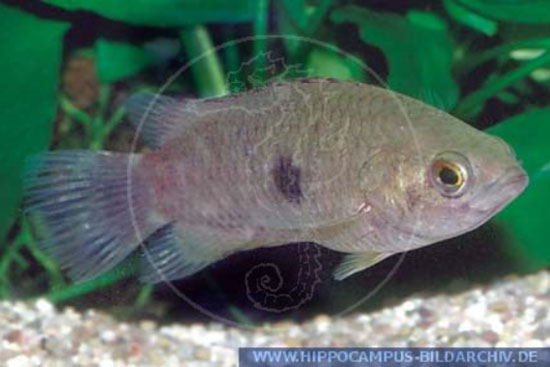| Anabantidae (Climbing gouramies) |
| 15 cm SL (male/unsexed) |
|
benthopelagic; freshwater; pH range: 6.5 - 7.5; dH range: 15, |
| Africa: southern Cameroon to Gabon, in the Sanaga, Nyong, Ntem, Ivindo, Ogowe and Rio Muni (Ref. 81650). Also in the Sangha drainage (Ref. 81650) in Cameroon (Ref. 51193) and the middle Congo River in Democratic Republic of the Congo (Ref. 4910). Report from the Chad basin (Ref. 6803) questionable. Report from Cameroon north of the Sanaga (Ref. 51193) unconfirmed in Ref. 81650. |
|
Dorsal spines (total): 15-17; Dorsal soft rays (total): 9-11; Anal spines: 7-9; Anal soft rays: 10-13; Vertebrae: 25-26. Diagnosis: centre of flank with dark, vertically oblong spot (sometimes obscured in darkly pigmented specimens)(Ref. 81650).
Description: snout relatively blunt; head profile straight or gently convex; mouth moderately protrusible; soft dorsal, anal and caudal fins finely scaled nearly to tips; 14-16 scales in upper lateral line, 8-13 in lower; 2.5-3 above upper lateral line, 7-9 below; 3-8 serrations above opercular notch, none within notch, 2-6 serrations below, 0-20 subopercular serrations, interopercle and preopercle entire (Ref. 81650).
Coloration: body and head medium brown or grey; centre of flank with dark, vertically oblong spot (sometimes obscured in darkly pigmented specimens); membrane in opercular notch frequently black; rare specimens with narrow, faint vertical bars on flanks; pelvic fin short and unpigmented in adults; in juveniles (up to ca. 30 mm SL), body and head dark brown broken by lighter mottling; dark band runs from snout through eye to opercular border; dark bar on underside of chin; some specimens also with additional dark streaks radiating from posterior border of orbit; mid-lateral spot surrounded by a light tan ring or situated in a light tan bar extending from dorsal fin origin to venter; pelvic fin of juveniles with dark pigmentation near its base; living specimens are various shades of brown (Ref. 81650). |
| Maximum TL reported 20.0 cm (Ref. 6803). |
|
Least Concern (LC); Date assessed: 16 February 2009 Ref. (130435)
|
| harmless |
|
Source and more info: www.fishbase.org. For personal, classroom, and other internal use only. Not for publication.

